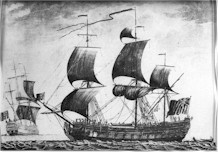HMS Culloden (1776) facts for kids

Engraving of HMS Culloden
|
|
Quick facts for kids History |
|
|---|---|
| Name | Culloden |
| Ordered | 30 November 1769 |
| Builder | Deptford Dockyard |
| Laid down | July 1770 |
| Launched | 18 May 1776 |
| Fate | Ran aground 23 January 1781 on Culloden Point, Montauk, New York and destroyed to avoid falling into the hands of the enemy. |
| Notes |
|
| General characteristics | |
| Class and type | Culloden-class ship of the line |
| Tons burthen | 1659 (bm) |
| Length | 170 ft (52 m) (gundeck) |
| Beam | 47 ft 2 in (14.38 m) |
| Depth of hold | 19 ft 11 in (6.07 m) |
| Propulsion | Sails |
| Sail plan | Full-rigged ship |
| Complement | 650 officers and men |
| Armament |
|
|
H.M.S. Culloden Shipwreck Site
|
|
| Nearest city | Montauk, New York |
| NRHP reference No. | 79003795 |
| Added to NRHP | 5 March 1979 |
HMS Culloden was a large warship of the Royal Navy, built in England and launched on May 18, 1776. She was a "74-gun ship of the line," meaning she carried 74 cannons and was strong enough to fight in a line of battle. This ship was the fourth British warship to be named after the Battle of Culloden, a famous battle in Scotland from 1746.
Contents
Culloden at War
The Culloden served during the American Revolutionary War, also known as the American War of Independence. She was part of the British Channel Fleet. One of her first big battles was the Battle of Cape St. Vincent in 1780.
After this battle, the Culloden sailed to the Caribbean. Her time there was short. In August 1780, she joined Admiral Rodney and headed to New York City. Her main job was to help block French ships near Newport, Rhode Island. A French army of 6,000 soldiers had landed there in July 1780.
Shipwreck in a Storm
On January 23, 1781, the Culloden was trying to stop French ships near Newport, Rhode Island. Suddenly, a very bad storm hit. The ship ran aground (got stuck) at North Neck Point in Montauk, New York. This area is now called Culloden Point.
The crew tried everything to get the ship unstuck, but it was impossible. Luckily, all the sailors were saved! The Culloden's masts (the tall poles that hold the sails) were taken off and put onto another ship, HMS Bedford.
What Happened to the Ship?
After the Culloden got stuck, the British worked to save what they could. They managed to pull out 28 of the 18-pounder cannons from the upper deck. They also got all 18 of the 9-pounder cannons from the quarterdeck.
The biggest cannons, the 32-pounders, were too heavy to move. So, they were pushed into the sea. To make sure the French couldn't use the ship, the British then burned the Culloden down to the waterline and left it.
Over the years, people found parts of the wreck. In 1781, a man named Joseph Woodbridge offered to sell George Washington sixteen 32-pounder cannons from the wreck. Later, in 1815, Samuel Jeffers arrived in Newport with 12 tons of iron and a 32-pounder cannon from the Culloden.

Discovering the Wreck Site
In 1971, Henry W. Moeller, an underwater archaeologist, found the main part of the Culloden wreck. He found the keel (the ship's backbone) and large wooden beams. They were resting in about 10 to 15 feet of water, about 150 feet off Culloden Point.
During these discoveries, a special metal part called a gudgeon was found. It had the name Culloden stamped on it! More recovery efforts brought up another 32-pounder cannon and copper plating that had covered the ship's bottom. A drawing of the wreck showed the ship resting on a large rock.
A Protected Historical Site
Since 1979, the Culloden shipwreck site has been listed on the National Register of Historic Places. This means it's a very important historical site that needs to be protected. Because it's protected, SCUBA divers are not allowed to take anything from the wreck or disturb it.
The protected area is a circle about 200 feet wide, centered at specific coordinates. The application to list the site mentioned that the shipwreck is important for several reasons. It shows how British ships were built during the Revolutionary War, especially with their advanced copper sheathing. Studying the wreck can help historians learn more about shipbuilding practices from that time.


